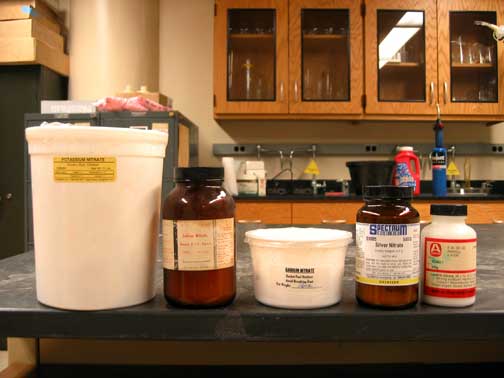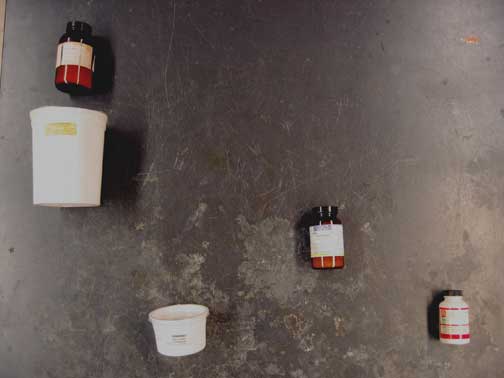Trends in reactivity and the Periodic Table
 A series of combustion reactions are used to explore trends in reactivity in a series of nitrates.
A series of combustion reactions are used to explore trends in reactivity in a series of nitrates.
Ingredients: sodium nitrate, potassium nitrate, barium nitrate, silver nitrate, lead nitrate, table sugar
Procedure: A minimal recipe follows.
1. Mix a small amount of nitrate with table sugar.
2. Place a small amount of each nitrate on a "brick" surface.
3. Ignite the nitrates in some order. Observe the similarities and differences in reactivity.
Understanding: Nitrates are considered strong oxidizing agents as they are sources of oxygen. Consider how potassium nitrate reacts to form potassium nitrite and molecular oxygen
2 KNO3(s) → 2 KNO2(s) + O2(g)
Potassium nitrate is found in mineral deposits and is commonly known as salt peter. The wonderful name "salt peter" is derived from the Medieval Latin "sal petrae" meaning "stone salt."  Like dioxygen, nitrates do not burn upon heating. They must be provided with something to eat - something to oxidize.
In our series of reactions, we provide the nitrates with something sweet to eat - sugar! Sugar is an excellent source of carbon which is readily oxidized in the presence of nitrate.
Like dioxygen, nitrates do not burn upon heating. They must be provided with something to eat - something to oxidize.
In our series of reactions, we provide the nitrates with something sweet to eat - sugar! Sugar is an excellent source of carbon which is readily oxidized in the presence of nitrate.
There is a variety of sugars - monosaccharides (like glucose, C6H12O6), disaccharides (like sucrose, table sugar, C12H22O11), and polysaccharides. The empirical formula for glucose is CH2O. The empirical formula for sucrose is almost CH2O. In our study, we will use a generic empirical chemical formula to represent our sugar, CH2O, that captures the essence of the ratio of carbon, hydrogen, and oxygen in most carbohydrates.
As is common in chemical biology, we will represent the reaction of sugar with oxygen as
CH2O(s) + O2(g) → CO2(g) + H2O(g)
As we understand the reaction of nitrates to form oxygen, and the reaction of sugar with oxygen, we can represent the reaction of nitrates with sugars.We think of the nitrate as the soul source of oxygen for the reaction with nitrate. An example of a balanced equation for the reaction of potassium nitrate with sugar is
2 KNO3(s) + CH2O(s) → 2 KNO2(s) + CO2(g) + H2O(g)
That is the reaction that is commonly found in sparklers, a combination of potassium nitrate, sugar, and metal filings. The reaction of sugar and nitrate makes heat, and the heat excites the metal filings, causing them to be oxidized and emit light. It is also the principal reaction in sugar rocket fuel. A mixture of sugar and potassium nitrate is a good rocket fuel as it represents the reaction of solids (nitrate and sugar) to form gases (carbon dioxide and water). The expansion creates thrust that is used to power the rocket!In our exploration of the reactivity of the nitrates, we prepare mixtures of sugar with sodium nitrate, NaNO3, potassium nitrate, KNO3, barium nitrate, Ba(NO3)2, silver nitrate, AgNO3, and lead nitrate, Pb(NO3)2. We observe the various reaction and note the relative reactivities. A clear trend can be established that is correlated with the placement of the metals cations (associated with the nitrate anions) on the Periodic Table.
Making better rocket fuel
Question: Potassium nitrate is commonly used in model rocket fuel. The fuel of the "sugar rocket" consists of potassium nitrate and sugar. Sulfur is sometimes added. Does that help to make a better rocket fuel?Carbon is often added in the form of charcoal, rather than sugar. For a fixed mass of fuel, do you expect the mixture of potassium nitrate and charcoal to provide more thrust than the sugar rocket fuel of potassium nitrate and sugar?